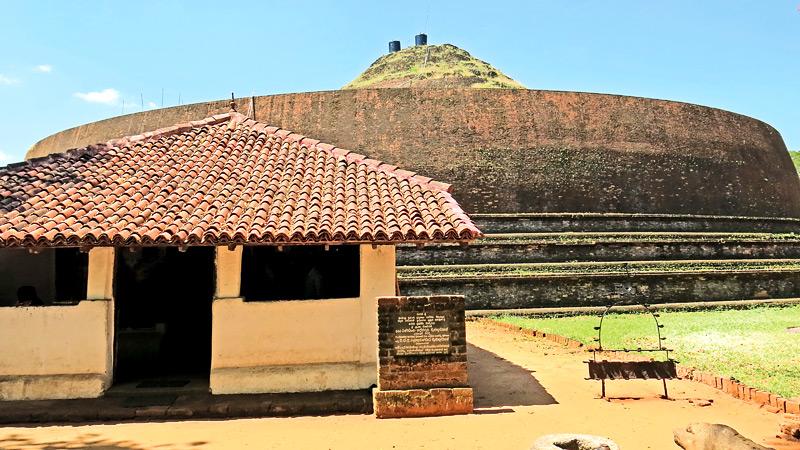
Uva-Wellassa is a unique historical region, where patriotic rulers, together with civilians, waged war and spilt blood for the sake of the sovereignty of the motherland. Buttala, a prosperous agriculture-based region in the Moneragala district lies in the Uva Province, 226 kilometres from Colombo.
 Across lush green paddy fields, a soft cool breeze blows through the leaves of massive Kumbuk trees. The shade and the soothing swishing sounds of leaves is mesmerising and engulfed us with its serenity. We are at the Yudaganawa chaitya.
Across lush green paddy fields, a soft cool breeze blows through the leaves of massive Kumbuk trees. The shade and the soothing swishing sounds of leaves is mesmerising and engulfed us with its serenity. We are at the Yudaganawa chaitya.
Situated in Buttala around two kilometres from the Moneragala-Wellawaya road, Yudaganawa is the largest chaitya in the Uva Province.
Rising nearly 27 metres, it is believed that the chaitya had been built during two different eras of the Anuradhapura and the Polonnaruwa kingdoms.
Fascinating folklore surrounds the interpretation on how Buttala derived its name. In the bygone era, Buttala was along the road that connected Ruhuna and Rajarata, and was called Guttahala. As legend has it, Buttala where a village hall stood providing meals for the countless soldiers who marched across the area, served as an important resting place during the era of King Dutugemunu.
Folklore
The village hall was called the Bath Hala (rice hall), which is thought to have become Buth Hala and then Buttala. However, another version says that due to the many battles that took place in Buttala, the name could have originated from Gushtihala, which later become Gutthala and finally Buttala. A few kilometres from Buttala, is another brick-built chaitya of Dematamal Vihara of historical significance, set amid lush green paddy fields. It is supposed to be the place where Prince Saddatissa took refuge, when he fled after losing a battle for the throne with his brother Dutugemunu. The Queen Mother, Vihara Maha Devi, saddened by the animosity between her two sons pleaded with them to make peace.
Consequently, the two brothers made peace with each other and to mark the occasion a colossal stupa was built on the battlefield where they had fought. The battlefield is known in Sinhala as Yudaganawa. Some historians believe that a chaitya was reconstructed and named Yudaganawa chaitya.
The chaitya is so large that it is difficult to frame it in the normal camera lens and needed a wide-angle lens. Some believe that it is bigger than the circumference of the base of Abhayagiriya chaitya which is considered the largest ancient stupa in Sri Lanka.
King Parakramabahu
However, in some earlier writings, the eminent archaeologist, Dr. Senerath Paranavitana said that the Yudaganawa chaitya was first built by King Parakramabahu the Great in memory of his mother Queen Ratnavali who was cremated here.
Dr. Paranavitana expounded the theory that the Yudaganawa chaitya, which looks unfinished, is in fact, complete. He said in the era that the chaitya was built, a few other stupas were also built in the same style. Among them were the Damila thupa in Polonnaruwa and the Sutighara chaitya in Dedigama.
Walking around the perimeter of this mammoth structure, I noticed that the chaitya, built with red bricks was not the typical one found elsewhere in the island as it seemed to be composed of only the base rings and a small round-like structure atop.
Although some experts give credence to the fact that Yudaganawa is a Kota Vehera where the main feature is that the construction work on the chaitya is stopped with the base rings (pesa walalu) and a small chaitya built on top, some say that the chaitya was incomplete due to Prince Saddatissa being summoned to Anuradhapura as a result of the failing health of King Dutugemunu.
The shrine room in front of the chaitya is a small structure with white-washed walls made of clay. Thought to have been built towards the end of the 18th century, according to a charter issued by King Sri Wickrama Rajasingha, the paintings on the inner and outer walls are said to be from the Kandyan era.
Paintings
I was awed by the dim surrounding that barely lit the intricate paintings that adorn the walls and the upper wooden ceiling. Most paintings on the outer walls and those on the wooden ceiling have faded with time. Here I had to use my camera flash which I reluctantly use for my photography.
In the vicinity of the Yudaganawa chaitya is the Yudaganawa wewa. It is believed that the clay needed to make bricks for the chaitya was dug from here. According to chronicles, the wewa had been built by King Mahanaga in 300 BC. In 1950, it had been renovated by the Irrigation Department. It covers 150 acres and irrigates 252 acres of paddy cultivation.
The wewa is quite picturesque, in the middle of which is a huge rock surrounded by the skeletons of dead trees and home to numerous birds. Villagers come here for a bath. The ancient concept of development in our native culture is once again evident here, the village, the temple, the wewa.
Observing this gigantic structure, we tried to imagine a time when this place was abuzz with many a battle. Yet it was hard for us to grasp that this secluded and breathtaking place could have been a site that had witnessed such episodes!
